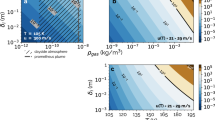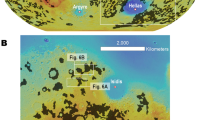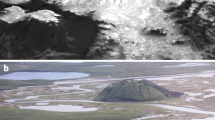Abstract
Mars has several different types of slope feature that resemble aqueous flows. However, the current cold, dry conditions are inimical to liquid water, resulting in uncertainty about its role in modern surface processes. Dark slope streaks were among the first distinctive young slope features to be identified on Mars and the first with activity seen in orbital images. They form markings on steep slopes that can persist for decades, and the role of water in their formation remains a matter of debate. Here I analyse the geomorphic features of new slope streaks using high-resolution orbital images. Comparison of images before and after streak formation reveal how this process affects the surface and provides information about the cause. These observations demonstrate that slope streaks erode and deposit material in some instances. They also reveal that streaks can jump slopes and may be erosive very near their termini. These observations support a formation model where dark slope streaks form as ground-hugging, low-density avalanches of dry surface dust. Such streaks need not be treated as Special Regions for planetary protection.
This is a preview of subscription content, access via your institution
Access options
Access Nature and 54 other Nature Portfolio journals
Get Nature+, our best-value online-access subscription
$29.99 / 30 days
cancel any time
Subscribe to this journal
Receive 12 print issues and online access
$259.00 per year
only $21.58 per issue
Buy this article
- Purchase on Springer Link
- Instant access to full article PDF
Prices may be subject to local taxes which are calculated during checkout




Similar content being viewed by others
Data availability
All of the data used in this study are available via the NASA Planetary Data System and/or the HiRISE team website at http://hirise.lpl.arizona.edu. Supplementary Table 1 provides the geographic locations of all images used.
References
Ferguson, H. M. & Lucchitta, B. K. Dark Streaks on Talus Slopes, Mars Technical Memorandum TM-86246 188–190 (NASA, 1984).
Sullivan, R., Thomas, P., Veverka, J., Malin, M. & Edgett, K. S. Mass movement slope streaks imaged by the Mars Orbiter Camera. J. Geophys. Res. 106, 23607–23633 (2001).
Malin, M. C. et al. Mars Observer Camera. J. Geophys. Res. 97, 7699–7718 (1992).
Williams, S. H. Dark talus streaks on Mars are similar to aeolian dark streaks. Lunar Planet. Sci. Conf. 22, 1509–1510 (1991).
Schorghofer, N., Aharonson, O. & Khatiwala, S. Slope streaks on Mars: correlations with surface properties and the potential role of water. Geophys. Res. Lett. 29, 2126 (2002).
Schorghofer, N., Aharonson, O., Gerstell, M. F. & Tatsumi, L. Three decades of slope streak activity on Mars. Icarus 191, 132–140 (2007).
McEwen, A. S. et al. Recurring slope lineae in equatorial regions of Mars. Nat. Geosci. 7, 53–58 (2014).
McEwen, A. S. et al. Seasonal flows on warm Martian slopes. Science 333, 740–743 (2011).
Morris, E. C. Aureole deposits of the Martian volcano Olympus Mons. J. Geophys. Res. 87, 1164–1178 (1982).
Ferris, J. C., Dohm, J. M., Baker, V. R. & Maddock T. III Dark slope streaks on Mars: are aqueous processes involved? Geophys. Res. Lett. 29, 1490 (2002).
Miyamoto, H., Dohm, J. M., Beter, R. A. & Baker, V. R. Fluid dynamical implications of anastomosing slope streaks on Mars. J. Geophys. Res. 109, E06008 (2004).
Baratoux, D. et al. The role of wind-transported dust in slope streaks activity: evidence from the HRSC data. Icarus 183, 30–45 (2006).
Kreslavsky, M. A. & Head, J. W. Slope streaks on Mars: A new “wet” mechanism. Icarus 201, 517–527 (2009).
Phillips, C. B., Burr, D. M. & Beyer, R. A. Mass movement within a slope streak on Mars. Geophys. Res. Lett. 34, L21202 (2007).
Gerstell, M. F., Aharonson, O. & Schorghofer, N. A distinct class of avalanche scars on Mars. Icarus 168, 122–130 (2004).
Chuang, F. C., Beyer, R. A., McEwen, A. S. & Thomson, B. J. HiRISE observations of slope streaks on Mars. Geophys. Res. Lett. 34, L20204 (2007).
Chuang, F. C., Beyer, R. A. & Bridges, N. T. Modification of Martian slope streaks by eolian processes. Icarus 205, 154–164 (2010).
Brusnikin, E. S. et al. Topographic measurements of slope streaks on Mars. Icarus 278, 52–61 (2016).
Bhardwaj, A., Sam, L., Martín-Torres, F. J., Zorzano, M.-P. & Fonseca, R. M. Martian slope streaks as plausible indicators of transient liquid water activity. Sci. Rep. 7, 7074 (2017).
Mushkin, A., Gillespie, A. R., Montgomery, D. R., Schreiber, B. C. & Arvidson, R. E. Spectral constraints on the composition of low-albedo slope streaks in the Olympus Mons Aureole. Geophys. Res. Lett. 37, L22201 (2010).
Edgett, K. S., Malin, M. C., Sullivan, R. J., Thomas, P. & Veverka, J. Dynamic Mars: new dark slope streaks observed on annual and decadal time scales. Lunar Planet. Sci. Conf. 31, 1058 (2000).
Aharonson, O., Schorghofer, N. & Gerstell, M. Slope streak formation and dust deposition rates on Mars. J. Geophys. Res. 108, 5138 (2003).
Bergonio, J. R., Rottas, K. M. & Schorghofer, N. Properties of Martian slope streak populations. Icarus 225, 194–199 (2013).
Schorghofer, N. & King, C. M. Sporadic formation of slope streaks on Mars. Icarus 216, 159–168 (2011).
Heyer, T. et al. Seasonal formation rates of Martian slope streaks. Icarus 323, 76–86 (2019).
McEwen, A. S. et al. Mars Reconnaissance Orbiter’s High Resolution Imaging Science Experiment (HiRISE). J. Geophys. Res. 112, E05S02 (2007).
Malin, M. C. & Edgett, K. S. Mars Global Surveyor Mars Orbiter Camera: interplanetary cruise through primary mission. J. Geophys. Res. 106, 23429–23570 (2001).
Burleigh, K. J. et al. Impact airblast triggers dust avalanches on Mars. Icarus 217, 194–201 (2012).
Dundas, C. M. et al. Granular flows at recurring slope lineae on Mars indicate a limited role for liquid water. Nat. Geosci. 10, 903–907 (2017).
Heyer, T., Hiesinger, H., Reiss, D., Erkeling, G., Bernhardt, H., Luesebrink, D. & Jaumann, R. The Multi-Temporal Database of Planetary Image Data (MUTED): a web-based tool for studying dynamic Mars. Planet. Space Sci. 159, 56–65 (2018).
Levy, J. S., Fountain, A. G., Gooseff, M. N., Welch, K. A. & Lyons, W. B. Water tracks and permafrost in Taylor Valley, Antarctica: extensive and shallow groundwater connectivity in a cold desert ecosystem. Geol. Soc. Am. Bull. 123, 2295–2311 (2011).
Bridges, N. T. et al. Aeolian bedforms, yardangs, and indurated surfaces in the Tharsis Montes as seen by the HiRISE Camera: evidence for dust aggregates. Icarus 205, 165–182 (2010).
Sullivan, R. & Kok, J. F. Aeolian saltation on Mars at low wind speeds. J. Geophys. Res. Planets 122, 2111–2143 (2017).
Herkenhoff, K. E. et al. Textures of the soils and rocks at Gusev crater from Spirit’s Microscopic Imager. Science 305, 824–826 (2004).
Moore, H. J. The Martian dust storm of Sol 1742. J. Geophys. Res. 90, D163–D174 (1985).
Moore, H. J., Hutton, R. E., Clow, G. D. & Spitzer, C. R. Physical properties of the surface materials at the Viking landing sites on Mars. US Geol. Surv. Prof. Pap. 1389, 222 (1987).
McEwen, A. S., Schafer, E., Sutton, S. & Chojnacki, M. Abundant Recurring Slope Lineae (RSL) following the 2018 planet-encircling dust event (PEDE). Lunar Planet. Sci. Conf. 50, 1376 (2019).
Wurm, G., Teiser, J. & Reiss, D. Greenhouse and thermophoretic effects in dust layers: the missing link for lifting of dust on Mars. Geophys. Res. Lett. 35, L10201 (2008).
Küpper, M. & Wurm, G. Thermal creep-assisted dust lifting on Mars: wind tunnel experiments for the entrainment threshold velocity. J. Geophys. Res. Planets 120, 1346–1356 (2015).
Schmidt, F., Andrieu, F., Costard, F., Kocifaj, M. & Meresescu, A. G. Formation of recurring slope lineae on Mars by rarefied gas-triggered granular flows. Nat. Geosci. 10, 270–274 (2017).
Kraemer, A., Teiser, J., Steinpilz, T., Koester, M. & Wurm, G. Analog experiments on thermal creep gas flow through Martian soil. Planet. Space Sci. 166, 131–134 (2019).
Gough, R. V., Nuding, D. L., Toigo, A., Guzewich, S. & Tolbert, M. A. An examination of atmospheric water vapor as a source for recurring slope lineae on Mars. In Ninth International Conference on Mars 6327 (Lunar and Planetary Institute, 2019).
Toyota, T., Kurita, K. & Spiga, A. Distribution and time-variation of spire streaks at Pavonis Mons on Mars. Planet. Space Sci. 59, 672–682 (2011).
Rummel, J. D. et al. A new analysis of Mars “Special Regions”: findings of the second MEPAG Special Regions Science Analysis Group (SR-SAG2). Astrobiology 14, 887–968 (2014).
Zurek, R. W. & Smrekar, S. E. An overview of the Mars Reconnaissance Orbiter (MRO) science mission. J. Geophys. Res. 112, E05S01 (2007).
Dundas, C. M., Diniega, S. & McEwen, A. S. Long-term monitoring of Martian gully formation and evolution with MRO/HiRISE. Icarus 251, 244–263 (2015).
Geissler, P. E. & Wilgus, J. T. The morphology of transverse aeolian ridges on Mars. Aeolian Res. 26, 63–71 (2017).
Acknowledgements
This work was funded by the NASA Mars Data Analysis Program under agreement number 80HQTR17T0022. HiRISE data were collected, processed and released by NASA/JPL/University of Arizona and the MRO project.
Author information
Authors and Affiliations
Corresponding author
Ethics declarations
Competing interests
The author declares no competing interests.
Additional information
Peer review information Primary Handling Editor: Stefan Lachowycz.
Publisher’s note Springer Nature remains neutral with regard to jurisdictional claims in published maps and institutional affiliations.
Extended data
Extended Data Fig. 1 Slope streaks fading rapidly and forming in concentrated bursts.
From a to b, the slopes were reset in less than one Mars year: virtually all existing streaks faded and were replaced by a large number of new streaks. From b to c, a handful of new streaks formed while the existing streaks remained distinct, possibly fading slowly, over nearly three Mars years. This demonstrates that the rapid fading and intense streak formation from a to b is not a characteristic of this site at all times, and instead indicates a fading/obliteration event and subsequent burst of streak formation, followed by reversion to a slower background rate of change.
Extended Data Fig. 2 Anaglyph demonstrating topographic control of a dark slope streak.
Downhill is to the right. The streak was interrupted by a ridge, which is likely 1-2 meters high based on the wavelength47. The flow proceeded obliquely downhill along the ridge until overtopping it at several local lows. This behavior is not expected for gradual seepage.
Extended Data Fig. 3 New slope streak straddling the edge of an old avalanche scar.
The shaded scar margin visible in a is along the median axis of the streak in b. This demonstrates that streaks need not remove the entire failure-prone layer. Additionally, while they can be controlled and deflected by subtle topography, the flow was capable of proceeding on both the high and low sides of the scarp with no effect on its behavior, indicating that it was a superficial phenomenon. Downhill is to the lower right.
Extended Data Fig. 4 Example of mass movement in a new slope streak.
Scarps and shading from lumpy dust deposits are visible in a, but an additional scarp with no corresponding feature is present in the new scarp in b (arrow), demonstrating movement of a thick body of dust. Also note numerous small patches within the streak that were unaffected by its passage. Downhill is to the left.
Extended Data Fig. 5 Example of mass movement in a new slope streak.
a is from before the streak formed, while b and c are after. Changes in topography are distributed throughout the streak and along the southern margin; arrows indicate particularly distinct examples such as pits or reshaping of surface features. Downhill is to the right.
Extended Data Fig. 6 Additional evidence for incision extending to near slope streak termini.
The ridges in the western part of panel a have narrow incised channels in the troughs between them, similar to Fig. 2. Panel b shows detail. This erosion stops at approximately the red dotted line, which is also the approximate distal limit for slope streaks at this site.
Extended Data Fig. 7 Example of a spire streak from Pavonis Mons.
The surface is generally flat, but the streak was capable of running up and over obstacles. The edges of the streak appear sharp at low resolution (a) but are jagged in detail (b), likely due to interactions between the wind and regular, subtle surface relief.
Supplementary information
Supplementary Information
Supplementary Table 3 and descriptive information for Data 1 and 2.
Supplementary Data 1
List of sites and coordinates; see Supplementary Information for details.
Supplementary Data 2
List of new slope streaks documented in this work; see Supplementary Information for details.
Rights and permissions
About this article
Cite this article
Dundas, C.M. Geomorphological evidence for a dry dust avalanche origin of slope streaks on Mars. Nat. Geosci. 13, 473–476 (2020). https://doi.org/10.1038/s41561-020-0598-x
Received:
Accepted:
Published:
Issue Date:
DOI: https://doi.org/10.1038/s41561-020-0598-x



